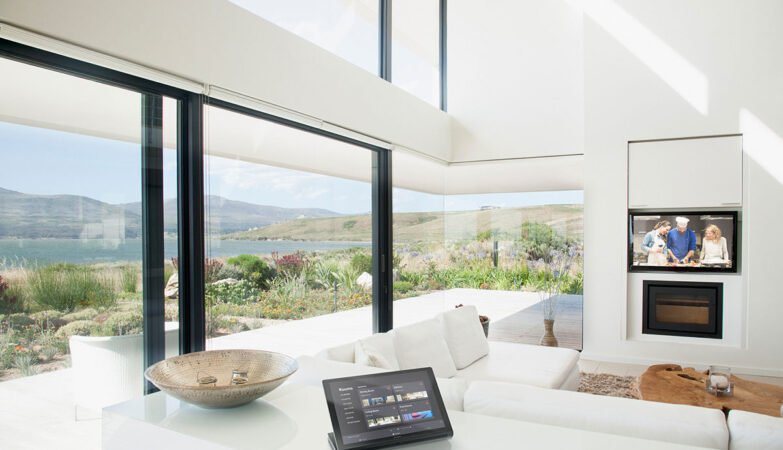The right landscaping can spruce up any front yard. One of the things to keep in mind, though, is the overall scale of the design. We’re talking about the ratio of tree size to the size of your home. For example, if you have a small home, you should plant smaller trees.
On the other hand, if you have a large home, you should plant larger trees to achieve the correct design scale. Here, we’ll go over some tips for tall tree landscaping. Here are five ideas to keep in mind when including tall trees in your landscaping design.
1. Plant Trees of Different Heights
Tall tree landscaping can serve many purposes. For instance, you may want to use tall trees as a privacy screen to shield your home from any prying eyes or plant shade trees in your front yard to shield yourself from the sun. In addition to their functionality, though, tall trees can also enhance your home’s curb appeal.
To create the most visually interesting landscape, you should plant trees according to height. We mentioned before that you should scale your trees to your home size. The trees planted nearest your home should be about the same height as your house. As you move outward, away from your home and closer to the curb, however, the trees you plant should be taller. This will create depth of field in your front yard and open up the space to make it more visually appealing.
You should also plant trees that are slightly taller than your home in your backyard. When viewed from the front of the yard, you should be able to see the treetops above the roof of your home. As the University of Missouri Extension notes, this will soften the appearance of your roofline and make your home stand out more.
2. Frame the House
When a home is properly framed by its landscaping, it appears longer and more aesthetically pleasing. To achieve proper framing, you should plant trees on an outward diagonal line from the front corners of your home. You should also avoid planting trees directly across from one another. Instead, stagger them so that they are not on exact opposite sides. Also, plant different types of trees rather than sticking to one kind. More on that in just a bit.
3. Use as a Windbreak
Shade trees are popular trees among homeowners because they serve several purposes. In the summertime, the large canopies of shade trees protect you from the sun. But they are just as useful during the winter months because they function as windbreaks and have the added benefit of cutting energy costs.
As the Department of Energy explains, windbreaks reduce energy costs by lowering the wind chill near your home. Wind chill is the outdoor “feels like” temperature. By blocking heavy winds, you can increase the “feels like” temperature, thereby reducing your home heating costs.
For the best results, plant your windbreak at a distance between two to five times the mature height of the trees. The Department of Energy also recommends planting small shrubs near your windbreak. This will help block wind close to the ground and trap the snow that blows near your home.
As we mentioned before, trees can serve many purposes. Windbreaks are no exception. In addition to blocking wind, they can serve as a barrier for sights, sounds, and smells. If you live in an urban area and want to block out city activity, planting a windbreak is a good way to do so. If you live in a more rural area, windbreaks can act as protection for livestock and wildlife habitats. And, of course, windbreaks are an excellent way to reduce home energy costs regardless of where you live.
4. Diversify Tree Type
Planting only one type of tree can give your home a static appearance. That’s why we recommend you plant several different types of trees instead. Diversifying your tall tree landscaping creates a contrasting arrangement that is much more interesting and pleasing to the eye.
This goes for the backyard as well. If you have the room, plant several different types of trees with one growing taller than the rest. This will ensure an irregular tree line which makes for the most visually appealing backdrop.
You can also plant an accent tree with unique characteristics, such as fruit, berries, or attractive leaves and bark to enhance your home’s appeal even more. Sprucing up your front and back yards with different types and textures of trees will create contrast and give your home a more inviting look.
5. Get Creative
You’ve done all the hard work of selecting the types of trees you want to plant and where they should be located. Now comes the fun part. Get creative with your tall tree landscaping. If you have a nice shade tree, for instance, maybe you want to build a swing set for the kids or a patio swing for the adults to lounge in on a nice, summer day.
If you plan to grow a strong oak tree in your backyard, maybe you can convert it into a treehouse. Or perhaps, you can build a deck around the trees in your backyard and use them for shade. Or maybe you want to incorporate some creative lighting around the house to highlight your landscaping at night. The options are as endless as your imagination.
These ideas are just the beginning. There are many other things you should know when it comes to planning your home landscaping. We’re available to help with all the major points as well as the finer details.
So if you need any more inspiration for your tall tree landscaping and you reside in the Pacific Northwest, reach out to us here at Mr. Tree. We can help you with all your tree service needs.





